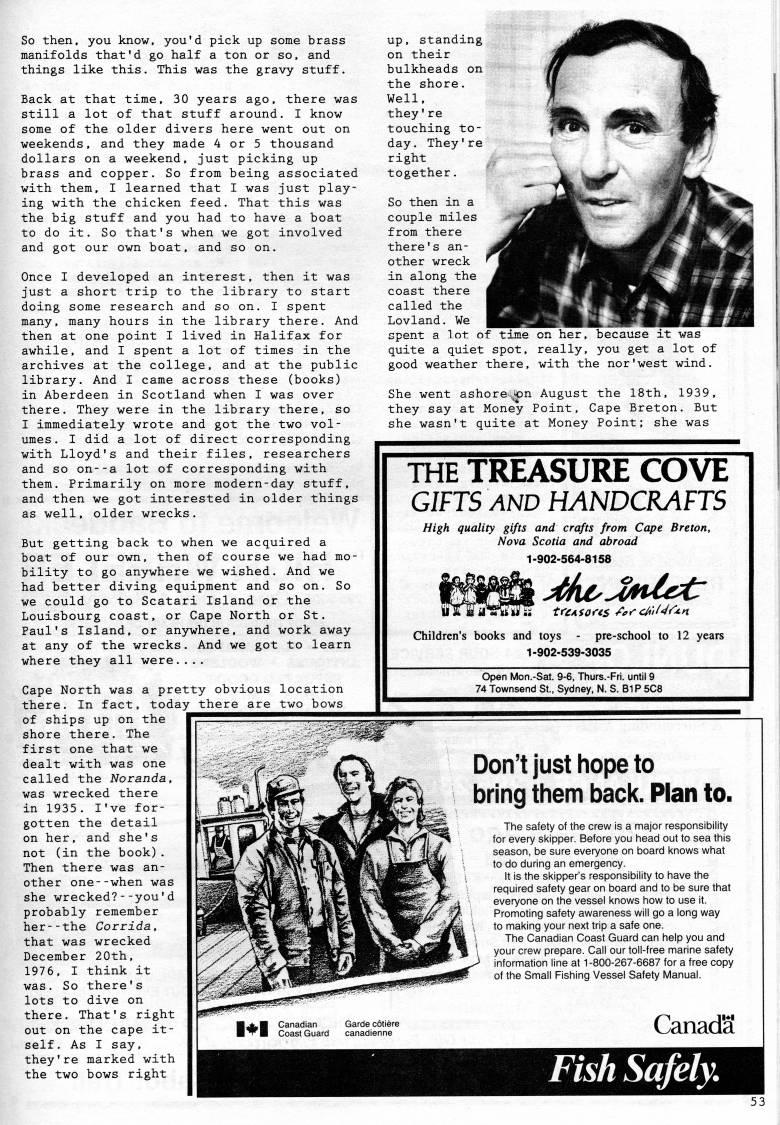Page 53 - Eddie Barrington: Early Diving Years
Published by Ronald Caplan on 1992/1/1 (218 reads)So then, you know, you'd pick up some brass manifolds that'd go half a ton or so. and things like this. This was the gravy stuff. Back at that time, 30 years ago, there was still a lot of that stuff around. I know some of the older divers here went out on weekends, and they made 4 or 5 thousand dollars on a weekend, just picking up brass and copper. So from being associated with them, I learned that I was just play? ing with the chicken feed. That this was the big stuff and you had to have a boat to do it. So that's when we got involved and got our own boat, and so on. Once I developed an interest, then it was just a short trip to the library to start doing some research and so on. I spent many, many hours in the library there. And then at one point I lived in Halifax for awhile, and I spent a lot of times in the archives at the college, and at the public library. And I came across these (books) in Aberdeen in Scotland when I was over there. They were in the library there, so I immediately wrote and got the two vol? umes. I did a lot of direct corresponding with Lloyd's and their files, researchers and so on--a lot of corresponding with them. Primarily on more modern-day stuff, and then we got interested in older things as well, older wrecks. But getting back to when we acquired a boat of our own, then of course we had mo? bility to go anywhere we wished. And we had better diving equipment and so on. So we could go to Scatari Island or the Louisbourg coast, or Cape North or St. Paul's Island, or anywhere, and work away at any of the wrecks. And we got to learn where they all were.... Cape North was a pretty obvious location there. In fact, today there are two bows of ships up on the shore there. The first one that we dealt with was one called the Noranda, was wrecked there in 1935. I've for? gotten the detail on her, and she's not (in the book). Then there was an? other one--when was she wrecked?--you'd probably remember her--the Corrida, that was wrecked December 20th, 1976, I think it was. So there's lots to dive on there. That's right out on the cape it? self. As I say, they're marked with the two bows right up, standing on their bulkheads on the shore. Well, they're touching to? day. They're right together. 'm H' W' So then in a couple miles from there there's an? other wreck in along the coast there called the Lovland. We spent a lot of time on her, because it was quite a quiet spot, really, you get a lot of good weather there, with the nor'west wind. She went ashore:.'n August the 18th. 1939. they say at Money Point, Cape Breton. But she wasn't quite at Money Point; she was THE TREASURE COVE GIFTS AND HANDCRAFTS High quality gifts and crafts from Cape Breton, Nova Scotia and abroad 1-902-564-8158 Children's books and toys - pre-school to 12 years 1-902-539-3035 Open Mon.-Sat. 9-6, Thurs.-Fri. until 9 74 Townsend St., Sydney, N. S. 81P 5C8 Don't just hope to bring them back. Plan to. The safety of the crew is a major responsibility for every skipper. Before you head out to sea this season, be sure everyone on board knows what to do during an emergency. It is the skipper's responsibility to have the required safety gear on board and to be sure that everyone on the vessel knows how to use it. Promoting safety awareness will go a long way to making your next trip a safe one. The Canadian Coast Guard can help you and your crew prepare. Call our toll-free marine safety information line at 1-800-267-6687 for a free copy of the Small Fishing Vessel Safety Manual. Canada Fish Safely.
Adobe Acrobat Reader is required to the PDF version of this content. Click here to download and install the Acrobat plugin





